
Fahnen, Flaggen und Kalender bei Fanshop-Online.de bestellen
This page is part of © FOTW Flags Of The World website.FOTW beschäftigt sich mit der Wissenschaft der Vexillologie (Flaggenkunde).
Alle auf dieser Website dargebotenen Abbildungen dienen ausschließlich der Informationsvermittlung im Sinne der Flaggenkunde.
Wir distanziert uns ausdrücklich von allen hierauf dargestellten Symbolen verfassungsfeindlicher Organisationen.
Brazilian Army: Historic Standards (Old-Style)
Last modified: 2010-11-13 by ian macdonald
Keywords: brazil | regiment | battalion |
Links: FOTW homepage |
search |
disclaimer and copyright |
write us |
mirrors
See also:
Old-Style Brazilian Army Standards
Although there are now standard patterns for Brazilian unit colors, Brazil, unlike other
countries, allows units that were granted "historic standards" during earlier periods to keep using the
same design originally granted.
Joseph McMillan, 2 June 2001
The images are from two sources: official Brazilian Army prints from
the 1940s in the files of the U.S. Army Institute of Heraldry and pictures
on various internet pages of the Brazilian Army and the units concerned.
Where I have found modern pictures of the standards from the 1940s, the
design has invariably remained unchanged. The use of these flags seems
to have begun in the 1930s.
Joseph McMillan, 17 May 2001
The "historic standards" granted by the Brazilian Army to its military units were originally of a
unique design for each unit--
combinations of stripes, saltires, borders, stars, crosses, etc., mainly but not exclusively in red and
blue, with badges, battle honors,
and other devices in silver, gold, and other colors.
Joseph McMillan, 20 June 2001
1st Motorized Infantry Battalion
Regimento Sampaio
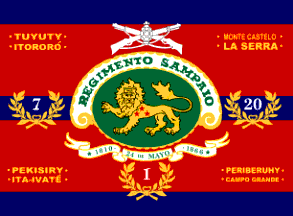 image by Joseph
McMillan
image by Joseph
McMillan
Formerly the 1st Infantry Regiment. The battalion claims a heritage
from the Terço Velho raised by Governor General Mem de Sá
to expel the French from Rio de Janeiro in the 17th century. The unit is
named for Brigadier Antônio de Sampaio, a hero of the War of the
Triple Alliance against Paraguay in the 1860s, who is considered the "patron"
of the Brazilian infantry.
Joseph McMillan, 17 May 2001
6th Motorized Infantry Battalion
Regimento Ipiranga
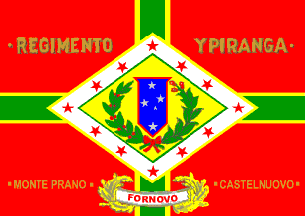 image by Joseph
McMillan
image by Joseph
McMillan
Formerly the 6th Infantry Regiment. Named after the river in the state
of São Paulo where Prince Regent Dom Pedro pronounced the grito
de Ipiranga, "liberty or death," on 7 September 1822, effectively considered
the declaration of Brazilian independence from Portugal. The old spelling of the place name is
inscribed on the flag, but the Brazilian Army lists the unit's "historic denomination" as "Ipiranga."
Joseph McMillan, 17 May 2001
11th Mountain Infantry Battalion
Regimento Tiradentes
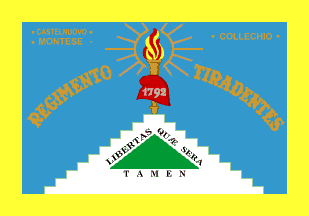 image by Joseph
McMillan
image by Joseph
McMillan
3rd Guards Cavalry Regiment
Regimento Osório
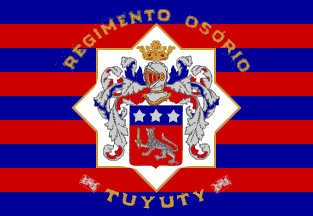 image by Joseph McMillan
image by Joseph McMillan
10th Cavalry Regiment
Regimento Antônio João
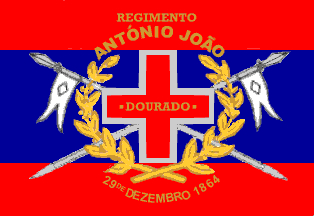 image by Joseph McMillan
image by Joseph McMillan
3rd Field Artillery Group
Regimento Mallet
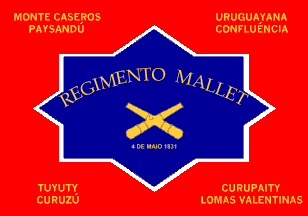 image by Joseph McMillan
image by Joseph McMillan
The Regimento Mallet is the senior artillery regiment in the Brazilian Army
and was the first regiment in the army to be granted a "historic standard."
The regiment is considered to be the lineal successor of the Corps of
Horse Artillery formed on 4 May 1831. It
participated in the war against the Rosas
dictatorship in Argentina in 1851 under the command of Major Emilio Luiz
Mallet, from whom it derives its "historic designation." The standard is
red, 80 x 120 cm according to current specifications (originally 80 x 110
cm), with a blue oblong eight pointed star, fimbriated white, bearing the
regimental designation, a pair of crossed cannons, and the date of the
regiment's founding, all in gold. In the corners of the flag are inscribed
the names of the battles in which the regiment had participated at the time
the standard was granted by Acting President Getúlio Vargas, by decree
21,196 of 23 March 1932. It is trimmed with gold fringe, and the standard
army cockade with streamers is attached below the
finial. This regiment is
also authorized to carry on parade a second historic standard, which is a
replica of one of the predecessor unit's standards from the imperial period.
Joseph McMillan, 11 March 2003
Hosted by: Fanshop-Online.de und Handy-Shop.de
Tipp: Apple iPhone XS Plus
 image by Joseph
McMillan
image by Joseph
McMillan





